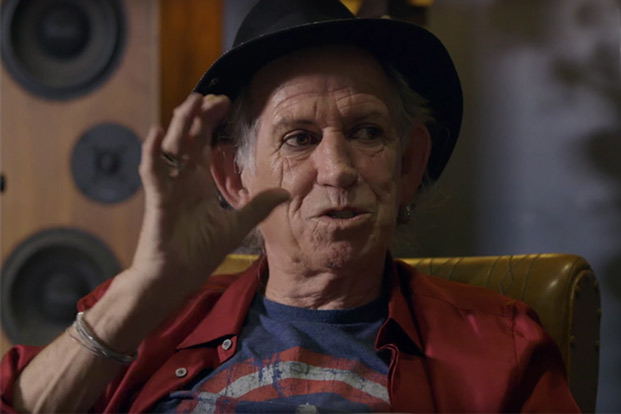Keith Richards: “‘Sympathy for the Devil’ Started Out as a Ballad”—and Five More Things We Learned

Noisey’s Matt Sweeney interviewed the Rolling Stones’ Keith Richards for his Guitar Moves program last fall as the then 71-year-old rocker promoted his solo album, Crosseyed Heart. That interview saw Richards discussing how he got turned onto guitar, his playing technique, and various firsts, including how he bought his first guitar and the first song he learned.
In this just-released second part of Sweeney’s interview, Richards talks about his musical heroes, the value of silence, and the Rolling Stones’ 1968 hit “Sympathy for the Devil,” whose creation was documented by French director Jean-Luc Godard in his film One Plus One. (The Rolling Stones’ footage from the film was also issued as a producer’s edit under the title Sympathy for the Devil).
Central to their discussion is how Richards came to discover the guitarists at the roots of blues and rock and roll.
“If this cat’s playing this on [guitar], what was his inspiration? Who was he listening to?” Richards asks, explaining his approach to learning about his guitar forebears. “’Cause if this cat turns you on so much, he must have listened to a cat that turned him on. So you find out who that is, and then you find the cat who turned the man who turned the man on.”
Here, we present six things we learned from part two of Richards’ interview.
1. Silence is golden. (1:08): “The 3-D of [music] is to leave this space, this little bit of silence there, and how to move it around,” Richards says. “There’s no formula for this: ‘I leave off here, I push here.’ I’ve always looked upon the silence as being an extra tool. It’s the instrument—and it doesn’t cost a lot. [laughs] ‘Cause it can produce that depth in a recording. If you fill it all up, the whole space is in your face.”
2. Creating great songs is a group effort. (2:29): “Some of those [songs] are struggles. But this to me is the great thing about recording and about making music. It really, when it comes down to it, it’s who you end up playing with and what material. It comes down to the song and the company.”
Get The Pick Newsletter
All the latest guitar news, interviews, lessons, reviews, deals and more, direct to your inbox!
3. “Sympathy for the Devil” started out as a ballad. (3:10): “Mick came in with a song, but it was… Great song, but it was very Dylanesque. It was like a ballad.” Richards explains that the song wasn’t working at first. “And, you know, you go through the process in the studio, which is the process I love of everybody going, ‘No, no. Let’s rethink. What if we, like, push the beat up a bit?
“So suddenly I’m on bass [and] it’s a samba. [laughs] But that to me is the beauty of recording, of going to a studio. You go in with some sort of semi-conceived idea of what you think this song is supposed to come out like, and it comes out something totally different because it’s been filtered through all of the other guys in the band.”
4. He was in the British Boy Scouts. (6:00): “I’d got into the Boy Scouts. For a while I just kept the musical thing to my side. I finally got expelled from the Scouts: ‘I’ll keep the knife.’ It was a sheath knife—a miniature Bowie.”
5. Listening to Elvis, his guitarist Scottie Moore and Chuck Berry taught him that rock and roll is about playing together as a group. (8:00): “Listening to Elvis, Scottie Moore and Chuck Berry… ‘Hey, this ain’t a one-man show; this is a band!’ I’m listening to bands playing together I’m listening to guys who know how to play with another. This is where it’s at. It’s the way these guys are playing together that is interesting. Especially listening to Buddy Holly and the Crickets. This is the template. Ask Paul McCartney. Ask John Lennon, if you could.”
6. Muddy Waters hipped him to Robert Johnson. (9:39): “We also realized that whoever Elvis and Buddy and Eddie [Cochran] were listening to were some other cats. And we quickly found out they were people like Chuck Berry, Little Richard, T-Bone Walker, Muddy Waters…
- “We knew nothing came out of a vacuum. When I realized that Muddy—when I finally met Muddy and we talked: [imitating Waters] ‘That Robert Johnson—that’s the cat.’ Then I realized I reached a kind of pinnacle of where I wanted to know where these guys are coming from.”
- And there are plenty of other great moments in the interview, so check it out.
Visit Noisey’s YouTube channel, and visit Noisey.com for more videos, daily news and more.
Christopher Scapelliti is editor-in-chief of Guitar Player magazine, the world’s longest-running guitar magazine, founded in 1967. In his extensive career, he has authored in-depth interviews with such guitarists as Pete Townshend, Slash, Billy Corgan, Jack White, Elvis Costello and Todd Rundgren, and audio professionals including Beatles engineers Geoff Emerick and Ken Scott. He is the co-author of Guitar Aficionado: The Collections: The Most Famous, Rare, and Valuable Guitars in the World, a founding editor of Guitar Aficionado magazine, and a former editor with Guitar World, Guitar for the Practicing Musician and Maximum Guitar. Apart from guitars, he maintains a collection of more than 30 vintage analog synthesizers.
“I knew the spirit of the Alice Cooper group was back – what we were making was very much an album that could’ve been in the '70s”: Original Alice Cooper lineup reunites after more than 50 years – and announces brand-new album
“Such a rare piece”: Dave Navarro has chosen the guitar he’s using to record his first post-Jane’s Addiction material – and it’s a historic build











